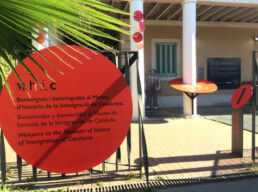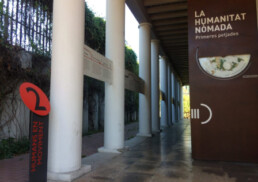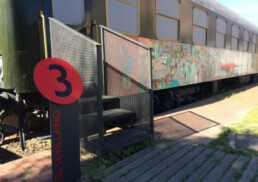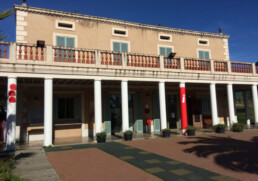Mhic's permanent exhibition is composed of three different areas, located at the exterior of the museum, that talk about migratory movements throughout the history of catalonia and the rest of the world.
SPACE 1. THE PLATFORM
Times of migrations.
This is the welcome area of the museum. MhiC has been conceived as a passage through various stations, where visitors transit and reflect on the migratory processes. What is migration? Which people migrate? Where do they go? How many migrants are there worldwide today? How many migrants are there in the towns, cities and neighbourhoods of Catalonia? How many families have a migratory history with diverse origins? What are migrants’ rights? How does society welcome them? This is an era of migrations, and we’re living in a world in constant motion. People’s journeys between countries create flows that transform societies and become inherent elements of the contemporary world. Our journey begins…

SPACE 2. HUMANS ON THE MOVE
Historical line. Migrations from prehistory to the 20th century.
Humans on the move attempts to consider history from the perspective of human mobility. Concepts and terminology associated with migration are examined by means of interactive and educational museographical elements. It’s an introductory journey from prehistory to the 20th century during which the visitors study concepts such as nomadism and the baggage linked to the migrants’ learning. We invite the public to experience prejudice and to analyse territoriality and identity as concepts associated with migratory processes. Finally, the reasons for migrations and the historical background of crossing seas and oceans are explained. We finish by taking a look at Catalonia and Sant Adrià de Besós, a region that has seen constant migrations since the 19th century.


STATIONS:
SPACE 3. SEVILLANO - BARCELONA - TERMINO
20th-century migrations. 20th century. The iconic train in which more than a million people arrived in Catalonia. A space full of emotions.
This exhibition is located inside a mid-20th century former train carriage. A major piece that pays homage to the people who arrived in Catalonia during the 20th century and without whom we would not be able to comprehend modern-day Catalonia. Inside this train, virtual passengers accompany the visitor along this journey with their testimonies and memories. The exhibition gives a central role to testimonies as the creators of the MhiC’s migratory collection and includes stories related to their journeys, life in the lands of origin and their arrival, settlement and daily life. A significant number of the visitors to the museum are people who travelled in El Sevillano, enabling us to examine and monitor the historical and testimonial aspects of the documentation of memories and objects that make up this heritage.


STATIONS:
SPACE 4. ESPAI [MIGRAR]
Migration and globalization in the 21st century Migrations in the era of globalisation.
Espai [MIGRAR]:is devoted to the migratory heritage of the 21st century. The MhiC is establishing this area as a living collection under construction. The exhibition area is located outdoors and it invites visitors to reflect on the most immediate present and the future of migration flows. It also raises questions about the reception and shelter offered and how society’s identity is being shaped. It’s a globalised space confined by different borders that enters the maze of the contemporary metropolis and the physical, emotional and bureaucratic routes that migrations take. Contributions by contemporary thinkers, a children’s game, letters and objects are the museum’s resources to examine the current migratory heritage. The metallic sound of the fenced enclosure posts conjures up the memories and uncomfortable facts of the present: migrant children, racism, colonialism and the boats in which migrants put to sea. The object stands out as a testimony of the heritage processes and cultural identity. The different interactive digitised resources offer an insight into historical and social aspects of immigration and showcase local-based social and artistic projects.
SPACE 5. MASIA CAN SERRA
Reception and temporary exhibitions venue.
The Masia building houses the head offices of the Museum of the History of Immigration in Catalonia and the temporary exhibitions that are renewed on a regular basis. The smaller room hosts reduced-format exhibitions that are often associated with public awareness campaigns and photography. The larger room displays the monographic exhibitions that broaden the discourse of the museum and its collection. They’re participatory projects with a major educational purpose. The building’s roof terrace can be visited on request; from here you can see both the museum garden and the urban landscape, whose development explains the migratory impetus and the construction of the metropolitan area. Crowned by the Tres Xemeneies (Three Chimneys) as outstanding landmarks of this landscape.


![ESPAI 4. ESPAI [MIGRAR]](https://www.mhic.cat/wp-content/uploads/2023/11/ESPAI-4.-ESPAI-MIGRAR-uai-258x258.png)
![ESPAI 4. ESPAI [MIGRAR]](https://www.mhic.cat/wp-content/uploads/2023/11/MHIC-ESPAI-4.-ESPAI-MIGRAR-IMG-uai-258x182.jpg)
